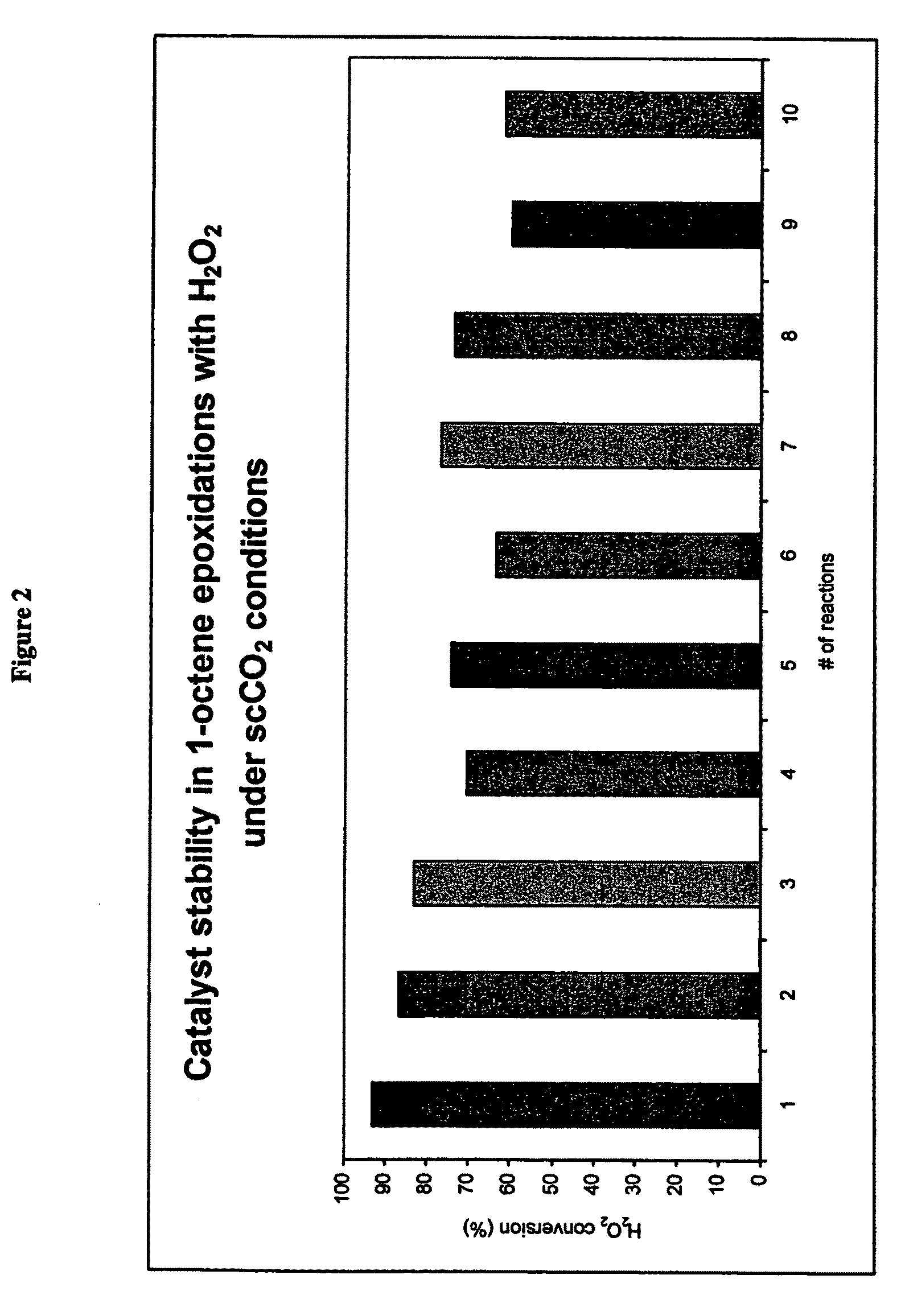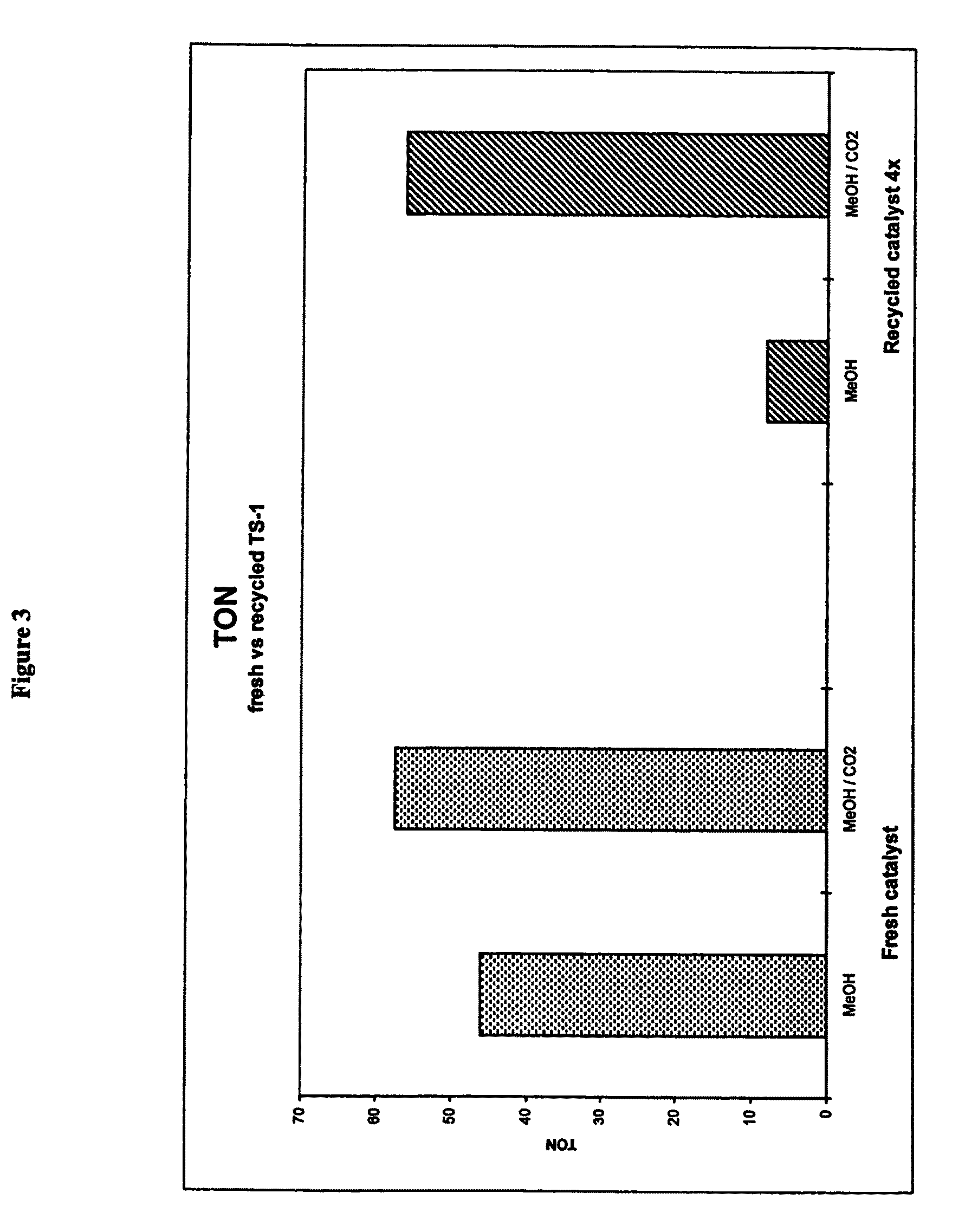Oxidation process in the presence of carbon dioxide
a carbon dioxide and oxidation process technology, applied in the field of oxidation process, can solve the problems of prior art processes, incur additional costs, and reduce the conversion selectivity of various reactions, so as to reduce solvent content, reduce the size of the reactor, and improve the utilization rate
- Summary
- Abstract
- Description
- Claims
- Application Information
AI Technical Summary
Benefits of technology
Problems solved by technology
Method used
Image
Examples
example 1
[0042]A TS-1 catalyst (prepared by the procedure given in Applied Catalysis, 99, (1993), pages 71-84) was utilised in the oxidation of 1-octene to 1,2-epoxyoctane with and without supercritical carbon dioxide as the solvent. A 250 cm3 batch autoclave equipped with a temperature controller, mechanical stirrer (1000 rpm), reagents feed line, sampling line and vent line was charged in two separate experiments with the following reagents.
[0043]
Experiment 1Experiment 2ReagentsWeight (g)Weight (g)1-octene14.527.26H2O2 (30 wt % in H2O)0.44*0.22*Methanol112.556.25Carbon Dioxide074.2TS-1 catalyst1.00.5Total128.46138.43*= the weight of H2O2does not include the weight of H20
[0044]For Experiment 1 the reaction was undertaken at 65° C. for 60 minutes. For Experiment 2 the reactor was first pressurised with carbon dioxide gas to 48 bar (48×105 Nm−2), after which 74.2 g of liquid carbon dioxide was added. The reaction was undertaken at 65° C. for 60 minutes and at a pressure of 106 bar (106×105 Nm...
example 2
[0048]In a further set of experiments the solvent system utilised was methanol or methanol / CO2 under supercritical conditions.
[0049]In a first set of experiments (Experiment 3) the TS-1 catalyst was used in a methanol solvent and recycled without treatment or regeneration. In a second set of experiments (Experiment 4) the TS-1 catalyst was used in a methanol / carbon dioxide solvent system under supercritical conditions with respect to the carbon dioxide again the catalyst was recycled without further treatment or regeneration.
Methanol Solvent—Catalyst Recycle
[0050]The following reagents were used:
[0051]
Experiment 3ReagentsWeight (g)1-octene7.26H2O2(30 wt % in H2O)0.22*Methanol56.3Carbon Dioxide0TS-1 catalyst0.5Total64.23*=the weight of H2O2 does not include the weight of H2O
[0052]The reaction was undertaken at 40° C. for 60 minutes in a 100 cm3 glass reactor with magnetic stirrer and chilled water cooler on an electrical heating mantle. On completion the reactor was recharged with re...
example 3
[0061]Example 1 was repeated with the exception that the reaction time was 30 minutes and the reaction temperature was 40° C. The results are provided in FIG. 4; these results illustrate that at short reaction times and low temperature the process of the invention provides improved selectivity and oxidant conversion.
PUM
| Property | Measurement | Unit |
|---|---|---|
| pressure | aaaaa | aaaaa |
| pressure | aaaaa | aaaaa |
| reaction temperature | aaaaa | aaaaa |
Abstract
Description
Claims
Application Information
 Login to View More
Login to View More - R&D
- Intellectual Property
- Life Sciences
- Materials
- Tech Scout
- Unparalleled Data Quality
- Higher Quality Content
- 60% Fewer Hallucinations
Browse by: Latest US Patents, China's latest patents, Technical Efficacy Thesaurus, Application Domain, Technology Topic, Popular Technical Reports.
© 2025 PatSnap. All rights reserved.Legal|Privacy policy|Modern Slavery Act Transparency Statement|Sitemap|About US| Contact US: help@patsnap.com



